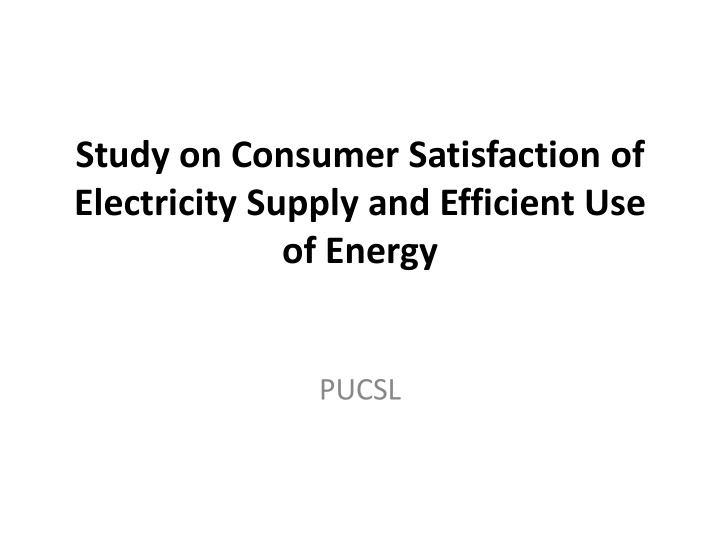



Study on Consumer Satisfaction of Electricity Supply and Efficient Use of Energy PUCSL
Objectives of the Survey 1. To obtain answers to: • Whether the consumers are satisfied with the present quality of electricity supply and electricity supply services • In which aspects the consumers expect to see improvements 2. To ascertain whether the consumers are fully convinced that electricity could be used more efficiently, • if not: identify; the information gaps to be filled by the Commission. Particularly, whether there are technology access issues that could be narrowed down through awareness programs. • If yes; assess how much effort consumers make to improve the energy efficiency and identify the information gaps that could be addressed through awareness programs.
Process • Two sets of questionnaires; 1- domestic sector 2- Rest • Face to face data collection, at home, with interviews lasting an average of 30 minutes • Total of 2500 interviews The individual rating of each consumer satisfaction item is based on a 1 to 5 scale, which allows consumers to carry out an evaluation.
Sample Survey covered following categories Sector/cate Element Importance gory for Consumer Domestic recognizing the categories - units/months: differences in energy needs 0-30,31-60, 61-90, 91- and the underline factors 120, 121-180,180 <) for the differences in usage for Industrial understanding the (IP1, IP2, IP3) impact of conservation Commercial campaigns conducted so far (GP1, GP2, GP3) on different consumer Hotels groups (HP1, HP2, HP3)
Sector/category Element Distribution Four regions of areas CEB and LECO (5) for comparison of administrative aspects and for bench marking and recognising best practices
Sector/category Element Importance • Rural Demographic • for understanding energy • Urban needs under different micro • Cities climatic conditions and life • Estate styles • for recognizing the differences in quality of the energy services provided
Sector/ Element Importance category for understanding the Income <12,500, levels 12,500- 20,000, relationship between 20,000 - 30,000, income level and consumer 30,000 - 45,000, satisfaction 45,000 - 65,000, 65,000< To recognize the Social No employment, self- status employed, unskilled consumption patterns of labourer, Skilled different social groups labourer, farmer, Government servant, Private sector employee, Businessman
Sector/ Element category Geographical Up country areas Low land-dry Zone Low land-wet Zone for understanding energy needs under different climatic conditions (e.g. space heating and cooling) for recognizing whether there are differences in quality of the energy services provided
Sample % of the % % of Sector DL1 DL2 DL3 DL4 LECO Total sample consumers population Domestic 400 400 400 400 400 2000 80% 89% 0.05 Religious 5 5 5 5 5 25 1% 1% 0.09 GP1 45 45 45 45 45 225 9% 9% 0.05 Industrial 1 20 20 20 20 20 100 4% 1% 0.25 Industrial 2 10 10 10 10 10 50 2% 0% 1.02 Industrial 3 2 2 2 2 2 10 0% 0% 5.43 Hotel 1 5 0% 0% 8.77 Hotel 2 3 3 3 3 3 15 1% 0% 6.61 Hotel 3 3 0% 0% 33.33 GP2 10 10 10 10 10 50 2% 0% 1.05 GP3 10 0% 0% 11.49 Total 2493 100 100%
Survey Findings The relationship between income level and Monthly electricity consumption 0-30 31-60 61-90 91-120 121-180 >180 45% 40% 35% % Consumers 30% 25% 20% 15% 10% 5% 0% <12,500 12,500- 20,000 20,000 - 30,000 30,000 - 45,000 45,000 - 65,000 65,000< Income level
Electricity Consumer Satisfaction among domestic sector consumer categories in Sri Lanka 70% 60% 50% % consumers 0-30 40% 31-60 61-90 91-120 30% 121-180 >180 20% 10% 0% 1 2 3 4 5 Level of Satisfaction
Important factors for consumer satisfaction 45% 40% 35% 30% 25% 20% 15% 10% 5% 0%
Recommend
More recommend